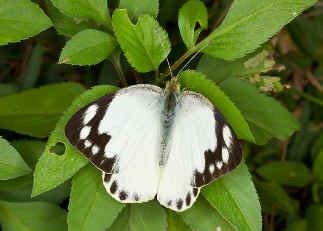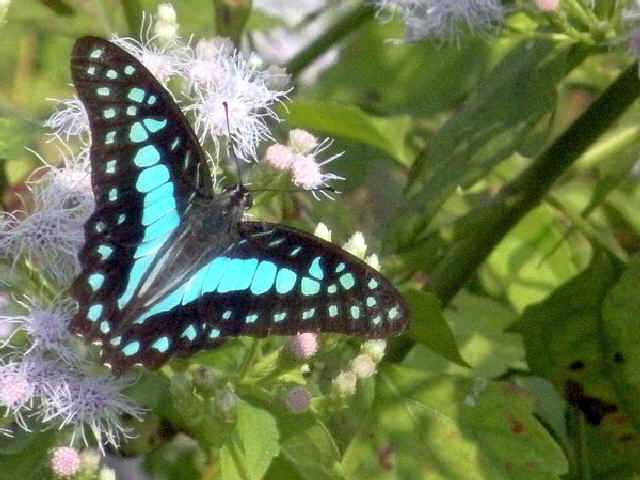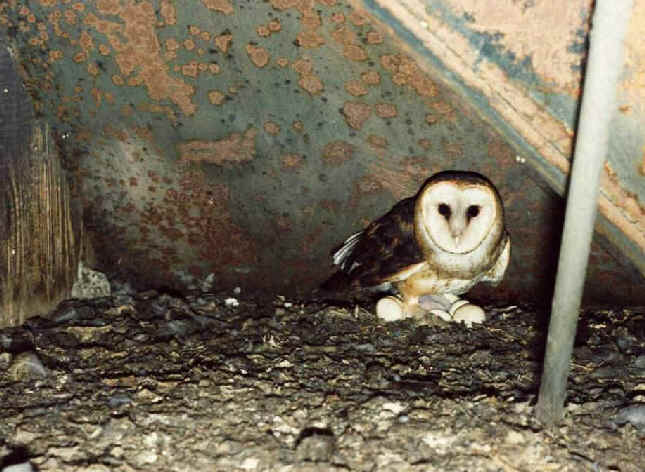With Gull, Albatross, Jay, Crow, Swift, Owl, and yes even
Puffin, all of them Butterflies
Before the butterflies just named in the title above,
some recent news about birds:
Last time, mention was made here of a FORK-TAILED
FLYCATCHER, from South America, being on Long
Island, New York on September 19.
That same day, a FORK-TAILED FLYCATCHER was in Maryland, in
Anne Arundel County.
In North America, most SWAINSON'S HAWKS are in the West.
But, in the East, last month, SWAINSON'S HAWKS were seen:
in New Hampshire on September 10 at the Pack Monadnock hawk
watch near Peterborough,
in Maryland on September 15, a dark morph, over Hooper's
Island, that was photographed, and
in New Jersey on September 25 at Cape May, near the hawk
watch at Cape May Point.
Most SWAINSON'S HAWKS, elsewhere, are now on their way to
Argentina.
At the north end of the New Jersey coast, a SAY'S PHOEBE was
found at Sandy Hook on September 27. 3 days later, a
SAY'S PHOEBE was at the south end of the New Jersey coast at
Cape May. The SAY'S PHOEBE is normally another Westerner.
SELASPHORUS HUMMINGBIRDS, from the West, have been in the
East. As many as 7 have been reported so far in Pennsylvania, including one noted here last time in
Allentown and Walnutport. All so far are known or assumed to
be RUFOUS HUMMINGBIRDS. The one in Allentown has been there
now for 3 weeks.
A RUFOUS HUMMINGBIRD has been the last couple days in Cape
May, New Jersey.
In upstate New York, in Phoenix, that is Phoenix NY, a there
has been a RUFOUS HUMMINGBIRD from September 17 until at
least September 29.
A WESTERN KINGBIRD was in Erie, Pennsylvania, at Presque
Isle, on September 29 & 30.
Also in Erie on September 29: an early RED-NECKED GREBE, a
LAPLAND LONGSPUR, and an EASTERN RED BAT that flew across
Lake Erie from Ontario, Canada.
As was the case for a while in August, a REDDISH EGRET
was at Brigantine Refuge in New Jersey, on September
29, only.
Last time, mention was made here of a LOGGERHEAD
SHRIKE, from Canada, in eastern Virginia.
Another LOGGERHEAD SHRIKE was recently seen elsewhere in Virginia,
on September 24, west of Mill Gap in Highland County.
Some of that endangered population of SHRIKES that nested in
Ontario, Canada this year were banded. Some were not.
If anywhere in eastern North America, you happen to
find a LOGGERHEAD SHRIKE, please check for a band, and
photograph if you can. Submit to Jessica Steiner at: jessica@wildlifepreservation.ca
PINE SISKINS have been appearing in the eastern US
recently, as far south so far as Delaware and probably
further.
In upstate New York, at Saranac Lake, there have been
numbers of PINE SISKINS, some EVENING GROSBEAKS visiting
feeders with sunflower seeds, and some RED CROSSBILLS feeding
on older cones of Red Spruce.
At feeders in Lake Placid, New York, PINE SISKINS have been
daily visitors, all this year, with typically about a dozen
or so, but in recent days nearly a hundred.
Some "northern birds" that will not come south
have been seen recently in Maine.
West of Baxter Park on September 20, there were both
BLACK-BACKED WOODPECKERS and AMERICAN THREE-TOED
WOODPECKERS, 4 of the former, 2 of the latter, plus 12
SPRUCE GROUSE, and 7 GRAY JAYS.
The MIGRATION of BIRDS has been well underway in the eastern
US.
At Cape May, New Jersey, from August 16 to September 30, MIGRANTS
have been counted, with over 30,000 PASSERINE BIRDS
during that time.
Over 10,000 of them were identified WARBLERS, with 34
species of WARBLERS.
On September 29, there was a massive flight of BLACKPOLL
WARBLERS, with an estimated 2,500.
Also counted at Cape May this season has been a record
of over 1,500 RED-BREASTED NUTHATCHES.
There have been above average numbers of RUBY-THROATED
HUMMINGBIRDS, BLUE-GRAY GNATCATCHER, and NORTHERN
WATERTHRUSHES.
Below average have been: NASHVILLE WARBLER, BLACK-THROATED
BLUE WARBLER, BLACK-THROATED GREEN WARBLER, and BALTIMORE
ORIOLE.
This Cape May summary is from a report well-done by Cameron
Rutt.
Another place that has been good for BIRD MIGRATION along
the east coast of the US has been Block Island, off the
coast of Rhode Island.
Seen there this past week have been: a NORTHERN WHEATEAR on
September 30, hundreds of RED-BREASTED NUTHATCHES, 3
CLAY-COLORED SPARROWS, BLUE GROSBEAK, PINE SISKINS,
and among the WARBLERS: CONNECTICUT, ORANGE-CROWNED, many
BLACKPOLLS, and YELLOW-BREASTED CHAT.
A NORTHERN WHEATEAR was reported earlier in September
in Massachusetts.
A Birdline reader in Thailand tells us (even that far
away) that she enjoys following our bird news and
commentary. Thanks, Pornrapee.
And another overseas Birdline reader and friend, Trevor in
Australia, has recently completed a well-done book about BUTTERFLIES
in his part of the world.
It's entitled "Butterflies of
Coastal Southeast Queensland, an Identification Guide",
and it can be viewed on line:
http://www.sunbittern.com/publications%20seq%20butterflies.pdf
When I was looking at the text and photos in that book,
I noticed that there were BUTTERFLIES with common
names that are often thought of as names of BIRDS. Such
as: GULL, ALBATROSS, and CROW.

A
butterfly called an Albatross
The CAPER, or AUSTRALIAN, GULL, Cepora perimale, is in
the PIERIDAE family as is the YELLOW, or COMMON, ALBATROSS,
Appias paulina.
Trevor tells us that the GULL and the ALBATROSS
are very similar, and that often, when seen only in rapid
flight, the butterfly is referred to as a "GULLBATROSS".
And of course, there's even more confusion as Appias
paulina, or the YELLOW ALBATROSS, is not always yellow,
but white. And the vernacular name COMMON ALBATROSS is often
given to another butterfly in the Appias genus, Appias
albina.
And having said that, some of the Appias butterflies of
Asia are called PUFFINS !
There is, for example, the MALAY PUFFIN, Appias cardena.
But back to the butterflies of coastal southeast Queensland,
Australia.
Among the DANAIDS, or MILKWEED BUTTERFLIES such as the
MONARCH, in the NYMPHALIDAE family, there are the
CROWS:
the COMMON CROW, Euploea core, and the PURPLE CROW, Euploea
tulliolus.
In the area of the western Pacific, there is also a
butterfly called the JAY.
The COMMON JAY, Graphium doson, is one of the SWALLOWTAILS.

The butterfly known as the Common Jay
The above photo of the COMMON JAY is elsewhere in this FONT website in the
listing of Japanese butterflies. As are photos of the
ALBATROSS, Appias paulina, by whatever name - actually with
one of its other common names, the CEYLON LESSER ALBATROSS.
And the DARK CERULEAN (a butterfly, not a warbler), the
PEACOCK, the SMALL BRANDED SWIFT, and the BROWN AWL.
Here's a link to see the photos just referred to:
http://www.focusonnature.com/JapanButterfliesList.htm
And, yes, in Asia, a PEACOCK can be either a bird or a
butterfly.
The SWIFTS are amongst (that's Australian) the SKIPPERS.
And while the AWL is not quite right for OWL, it's
close.
And actually, there are OWL BUTTERFLIES in the American
tropics, in the Caligo genus and others. Big, often
brownish, butterflies with large "eyes" on their
wings, that tend to fly as darkness falls.
Lastly in this thread, there are BUTTERFLIES in Asia called
BIRDWINGS even though they have, of course,
"BUTTERFLY-WINGS".
And while to a person who knows & likes BIRDS, the
name SWALLOW-TAILED KITE conjures a nice image, the name
KITE-SWALLOWTAIL does so as well for one who knows &
likes BUTTERFLIES.
Referring to BUTTERFLIES now in eastern North
America:
In August 2012, a study was released that related some
notable changes in BUTTERFLY POPULATIONS in the northeastern
US, in Massachusetts.
The Harvard study, conducted over 2 decades, found that
populations of WARM-CLIMATE-ADAPTED BUTTERFLIES
increased by as much as a thousand fold, while those of
COLD-CLIMaTE-ADAPTED SPECIES, that have been native to
Massachusetts, declined substantially, by as much as 90 per
cent.
Data was collected by the Massachusetts Butterfly Club, an
amateur naturalist group that tracks butterfly sightings and
numbers.
17 of 21 NORTHERN BUTTERFLY SPECIES in
Massachusetts were found to be declining, including the
ATLANTIS FRITILLARY and the ACADIAN HAIRSTREAK.
12 SOUTHERN BUTTERFLY SPECIES, which were rare or unseen in
Massachusetts in the 1980s & 1990s, were found to have
increased tremendously, especially in warmer parts of the
state.
Such species include the ZABULON SKIPPER and the GIANT
SWALLOWTAIL.
For most of the species in the study, climate change seems
to be a stronger cause than habitat change.
Historically, it's interesting to note that there was an
incursion of the GIANT SWALLOWTAIL in the northeastern US in
the late 19th Century, in the 1870s & 1880s, as chronicled
by various entomologists.
Later, in the 20th century, that butterfly virtually
disappeared in the northeastern US.
During the past few weeks, some SOUTHERLY BUTTERFLIES have
made their way north, as they tend to do in the late summer:
LONG-TAILED SKIPPERS have been seen in at least 9 counties
in New Jersey: Atlantic, Bergen, Burlington, Camden, Cape
May, Cumberland, Morris, Ocean, and Somerset.
Other southerners seen lately in New Jersey have included:
OCALA SKIPPERS, COMMON CHECKERED-SKIPPERS, CLOUDLESS
SULPHURS, and apparently the 4th GIANT SWALLOWTAIL in
New Jersey this year in Ocean County.
Earlier I referred to OWL-BUTTERFLIES. Now, here, let's
refer to OWLS (the birds):
One of the best books anywhere about OWLS was published
earlier this year.
It's entitled "Owls of the World, A Photographic
Guide", by Heimo Mikkola. In the book, the photographs
of virtually every OWL in the world, are tremendous,
and the text is informative and excellent.
Heimo Mikkola is an owl expert who has been studying
OWLS for a long time. Another book of his, "Owls of
Europe" has long been in my library. It was
published in 1983.
In the 2012 book, there is some interesting "new"
taxonomy, including:
the AMERICAN BARN OWL split from that in the Old
World, along
with some other BARN OWLS in the area of the Caribbean,
the splitting of OWLS in the Galapagos Islands, both the
BARN and the SHORT-EARED OWLS,
and the splitting of the FERRUGINOUS PYGMY OWL into various
"species" including the RIDGWAY'S PYGMY OWL in
Central America, and the CHACO PYGMY OWL in, among other
places, southwestern Brazil.
A number of other adjustments have been made to SCREECH OWLS
and other PYGMY OWLS in Central & South America.
The MOTTLED OWL is treated as an exclusively South American
species, with now the MEXICAN WOOD OWL in Mexico &
Central America.
In all, there are 249 different OWLS in the book.
Links follow here to the updated information about OWLS
in the book noted above.
In North America:
http://www.focusonnature.com/BrazilBirdListPart2.htm
Lastly, here, the note that in South America, the World Land
Trust is currently working to preserve rainforest in
the Serra Bonita mountains in eastern Brazil that is habitat
supporting rare & endemic flora & fauna, including
critically endangered MONKEYS, the YELLOW-BREASTED CAPUCHIN
and the GOLDEN-HEADED LION TAMARIN.
Thought you might like to know that the effort is being
made.
What might also be of interest: a photo with
over 30 STELLER'S EIDER. To see it, click the link: www.focusonnature.com
The Birdline & Natureline are affiliates of
Focus
On Nature Tours.
Armas Hill has presented the Birdline, originally from
Philadelphia, on the phone and the internet for over 3
decades, and on the radio in Delaware for 10 years.
For an archive of some previous Birdlines & Naturelines:





